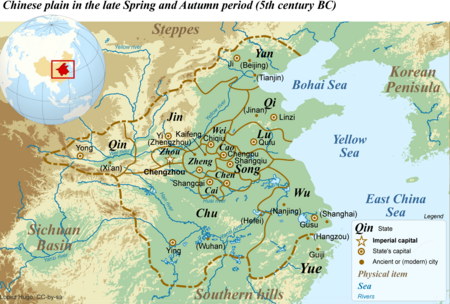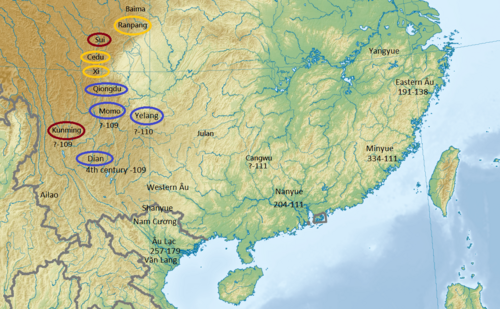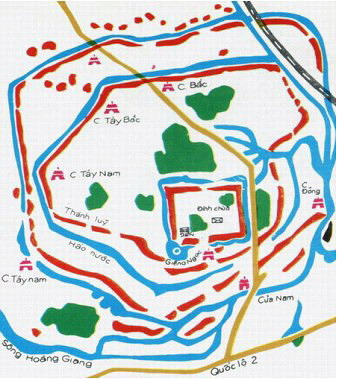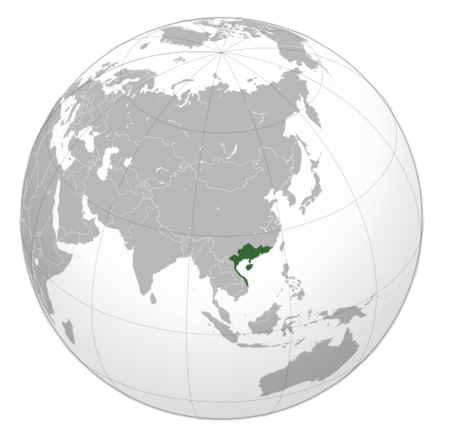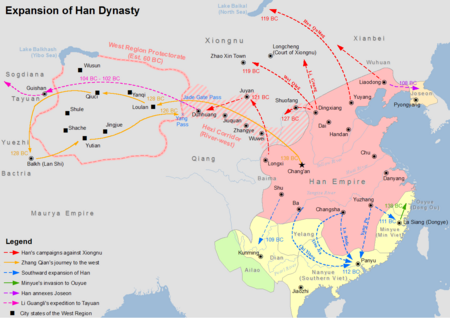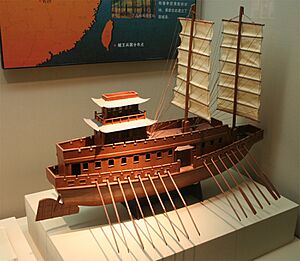Baiyue facts for kids
Quick facts for kids Baiyue |
|||||||||||||||||||||||||||||||||||||||||||||||||||
|---|---|---|---|---|---|---|---|---|---|---|---|---|---|---|---|---|---|---|---|---|---|---|---|---|---|---|---|---|---|---|---|---|---|---|---|---|---|---|---|---|---|---|---|---|---|---|---|---|---|---|---|
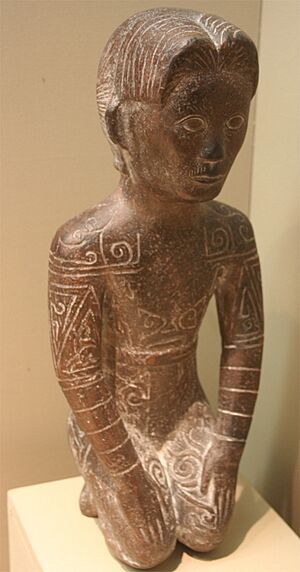
Statue of a man with short hair and body tattoos typical of the Baiyue, from the state of Yue
|
|||||||||||||||||||||||||||||||||||||||||||||||||||
| Chinese name | |||||||||||||||||||||||||||||||||||||||||||||||||||
| Chinese | 百越 | ||||||||||||||||||||||||||||||||||||||||||||||||||
| Literal meaning | Hundred Yue | ||||||||||||||||||||||||||||||||||||||||||||||||||
|
|||||||||||||||||||||||||||||||||||||||||||||||||||
| Vietnamese name | |||||||||||||||||||||||||||||||||||||||||||||||||||
| Vietnamese alphabet | Bách Việt | ||||||||||||||||||||||||||||||||||||||||||||||||||
| Chữ Hán | 百越 | ||||||||||||||||||||||||||||||||||||||||||||||||||
The Baiyue, also known as the Hundred Yue or simply Yue, were many different groups of people. They lived in parts of Southern China and Northern Vietnam thousands of years ago. These groups were known for their short hair, body tattoos, amazing swords, and strong navies.
During the Warring States period, the name "Yue" often referred to the powerful state of Yue in a region called Zhejiang. Later, kingdoms like Minyue in Fujian and Nanyue in Guangdong were also considered Yue states. The Yue people lived in a huge area, from Jiangsu to Yunnan. Over time, as the Han empire grew, many Yue tribes either moved away or blended into Chinese culture. Today, some southern Chinese dialects still have words from the ancient Yue languages. The name "Yue" is also used in modern Vietnam, in Yue opera, the Yue Chinese language, and as a short name for Guangdong.
Contents
What Does "Yue" Mean?
The word "Yue" (traditional Chinese: 越; ; pinyin: Yuè; Cantonese Jyutping: Jyut6; Wade–Giles: Yüeh4; Vietnamese: Việt) comes from an old Chinese word. It was first written using a picture of an axe around 1200 BC. Later, it was written with a different character. At first, it described people or leaders living northwest of the Shang dynasty.
In the 8th century BC, a group near the Yangtze River was called the Yangyue. This term was later used for people further south. Between the 7th and 4th centuries BC, "Yue" mainly referred to the state of Yue and its people. The term "Baiyue" (meaning "Hundred Yue") appeared around 239 BC. It became a general name for many non-Chinese groups in Southern China and Northern Vietnam.
Different Yue Groups
Ancient writings mention several different Yue groups. Many of these names were still used when the first empires began:
| Chinese Name | Mandarin Name | Vietnamese Name | What it Means |
|---|---|---|---|
| 於越/于越 | Yuyue | Ư Việt | Yue of Wuyu |
| 揚越 | Yangyue | Dương Việt | Yue of Yangzhou |
| 東甌 | Dong'ou | Đông Âu | Eastern Ou |
| 閩越 | Minyue | Mân Việt | Yue of Min |
| 南越 | Nanyue | Nam Việt | Southern Yue |
| 山越 | Shanyue | Sơn Việt | Mountain Yue |
| 雒越 | Luoyue | Lạc Việt | |
| 甌越 | Ouyue | Âu Việt | Yue of Ou |
| 滇越 | Dianyue | Điền Việt | Yue of Dian |
A Look at Yue History
Early Yue Groups
During the early Zhou dynasty, Chinese people met a group called the Yuyue. We are not sure if they were connected to the later Yue groups.
The Wu and Yue States
Around 900 BC, two northern Yue tribes, the Gouwu and Yuyue, started to be influenced by Chinese culture. They lived in what is now southern Jiangsu and northern Zhejiang. The Gouwu later formed the state of Wu, and the Yuyue formed the state of Yue. These two states were rivals and often fought. Other Chinese states saw them as very similar, with unique appearances.
The Wu state became more like the Chinese. Its royal family claimed they were related to the Zhou dynasty. The Yue state's history began with King Yunchang around 497 BC. The origins of the Yue kings are not fully clear. Some say they came from the Xia dynasty, others from the Chu state.
Wu and Yue were often at war. The Yue gained a strong reputation for being fierce fighters. One old text said, "Do not attack Yue, for Yue is [like] a cruel tiger."
After the state of Yue fell in 330 BC, its ruling family moved south to Fujian. There, they started the kingdom of Minyue. They stayed there, mostly out of Chinese history, until the Qin dynasty rose to power.
In 512 BC, Wu attacked the large state of Chu. Wu and Yue fought many wars over the next 30 years. In 473 BC, King Goujian of Yue finally conquered Wu. Later, in 333 BC, Yue was conquered by Chu.
The Qin Dynasty and the Yue
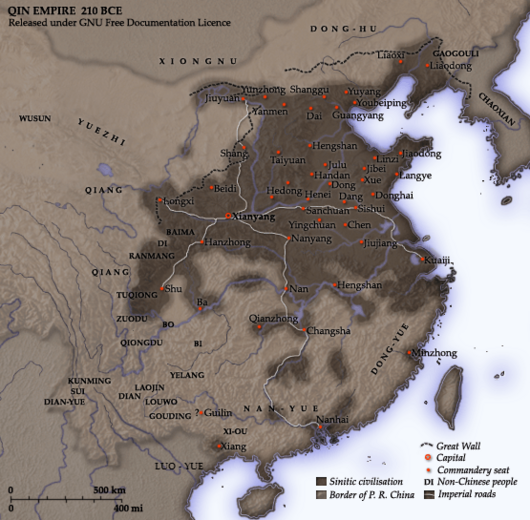
After China was united by Qin Shi Huang, the first emperor, the former Wu and Yue states became part of the new Qin empire. Qin armies also moved south into modern Guangdong. The emperor wanted the region's vast land and valuable goods. He sent a huge army of half a million soldiers to conquer the Yue lands.
The Yue fought back and defeated the first Qin attack, even killing the Qin commander. An old text says the Yue "fled into the depths of the mountains and forests, and it was not possible to fight them." The Qin soldiers became tired. Then, the Yue attacked and caused a big defeat for the Qin.
Qin Shi Huang sent more soldiers and built the Lingqu Canal. This canal connected the north and south, making it easier to send supplies. By 214 BC, the Qin had taken control of modern Guangdong, Guangxi, and northern Vietnam. The emperor also sent many Chinese farmers and soldiers to live in these areas.
Minyue and Dong'ou
When the Qin dynasty ended in 206 BC, two Yue leaders, Zou Wuzhu and Zou Yao, were not made kings by the new ruler. So, they joined Liu Bang in fighting against him. When Liu Bang won in 202 BC, he made Zou Wuzhu king of Minyue and Zou Yao king of Dong'ou. Both kingdoms claimed they were related to King Goujian of Yue.
In 154 BC, a Han prince rebelled and tried to get Minyue and Dong'ou to join him. Minyue refused, but Dong'ou helped the rebels. When the prince was defeated, Dong'ou killed him to avoid trouble with the Han.
Later, in 138 BC, Minyue attacked Dong'ou. Dong'ou asked the Han for help. The Han emperor sent an army by sea. By the time they arrived, Minyue had left. The king of Dong'ou decided to move his people into Han territory, and they settled near the Yangtze and Huai Rivers.
In 137 BC, Minyue invaded Nanyue. The Han sent an army, but the Minyue king was killed by his brother, who made peace with the Han. Later, this brother, Zou Yushan, secretly made himself king.
In 112 BC, Nanyue rebelled against the Han. Zou Yushan pretended to help the Han but secretly stayed in touch with Nanyue. The Han emperor decided to attack Minyue. Zou Yushan attacked first, killing three Han commanders. In winter, the Han attacked Minyue with a large army. A local Yue leader, Wu Yang, rebelled against Zou Yushan and killed him. The Han emperor decided it was too hard to control Minyue. He ordered the people to move to areas between the Yangtze and Huai Rivers, leaving modern Fujian empty.
Lạc Việt
Lạc Việt, known as Luoyue in Chinese history, was a group of Yue tribes in what is now Guangxi and northern Vietnam. Vietnamese stories say the Lạc Việt founded a state called Văn Lang around 2879 BC. They were ruled by the Hùng kings, who were descended from a dragon lord and a goddess.
Even with these legends, the history of Lạc Việt really begins in the 7th century BC. The first Hùng king united the different tribes. In 208 BC, the Western Ou king, Thục Phán, conquered Văn Lang.
Âu Việt
The Âu Việt, or Ouyue in Chinese, lived in modern northeast Vietnam and parts of China. Around 208 BC, Thục Phán conquered the Lạc Việt state of Văn Lang. He renamed it Âu Lạc and became known as An Dương Vương.
An Dương Vương built a famous fortress called Cổ Loa. Its walls were built in circles, like a snail shell. A legend says that a golden turtle helped him finish the fortress. When the turtle left, it gave An Dương Vương one of its claws. He used it to power a magical crossbow.
In 179 BC, An Dương Vương agreed to be under the Han dynasty's rule. This made Zhao Tuo of Nanyue angry, and he attacked Âu Lạc. Zhao Tuo's first attack failed. Legend says Zhao Tuo's son tricked An Dương Vương's daughter and stole the magical turtle claw. Without its protection, Âu Lạc was conquered when Zhao Tuo attacked again.
Nanyue Kingdom


Zhao Tuo was a Qin general. He was born around 240 BC in the state of Zhao. He helped the Qin conquer the Baiyue. The Yue lands were divided into three provinces. Zhao Tuo became a leader in one of them. Before his commander died, he advised Zhao Tuo to create his own independent kingdom.
Zhao Tuo took control of the provinces and declared himself King Wu of Nanyue (Southern Yue). Unlike the Qin emperor, Zhao Tuo respected Yue customs. He encouraged Chinese settlers to marry local Yue people. He created a new culture that mixed Han and Yue traditions.
In 196 BC, the Han emperor recognized Zhao Tuo as king of Nanyue. Zhao Tuo agreed to be a nominal subject of the Han. In 185 BC, the Han stopped trading iron and horses with Nanyue. Zhao Tuo reacted by calling himself Emperor Wu of Nanyue and attacking a nearby kingdom. He also began to control other nearby Yue kingdoms.
In 180 BC, the Han emperor tried to make peace with Zhao Tuo. He honored Zhao Tuo's parents' graves and gave high jobs to his cousins. Zhao Tuo then stopped using the title of emperor when talking to the Han, but still used it within his own kingdom. Trade with the Han started again. In 179 BC, Zhao Tuo conquered the kingdom of Âu Lạc.
Zhao Tuo died in 137 BC. His grandson, Zhao Mo, became king. When Minyue attacked Nanyue, Zhao Mo asked the Han for help. The Han sent troops, but the Minyue king was killed by his brother, who surrendered. Zhao Mo thought about visiting the Han court to say thank you, but his advisors told him not to. Zhao Mo died in 122 BC.
Later, in 113 BC, the Han emperor wanted Nanyue to become even closer to the Han. The Queen Dowager Jiu, who was Chinese, agreed. But the prime minister of Nanyue, Lü Jia, had a lot of power. He refused to meet the Han envoys. The Queen Dowager tried to kill him, but failed.
When the Han emperor heard about this, he sent an army. Lü Jia quickly took action, killing the king, the Queen Dowager, and the Han envoys. He made the king's brother, Zhao Jiande, the new king. The Han emperor was very angry. He sent a huge army of 100,000 soldiers to attack Nanyue. In the winter of 111 BC, the Han army captured the Nanyue capital. Jiande and Lü Jia tried to escape but were caught and executed.
Dianyue Kingdom
In 135 BC, a Han envoy convinced the king of Yelang, a kingdom next to the Dian Kingdom, to submit to the Han. In 122 BC, the Han emperor sent explorers to the southwest. They met the king of Dian. They learned that further west was a kingdom called Dianyue. The people there rode elephants and traded secretly with merchants.
Han Dynasty Rule
In 111 BC, the Han conquered Nanyue and ruled it for several hundred years. The Han wanted to control the sea trade routes and get luxury goods like pearls, incense, and exotic animals from the south. Panyu was already a major trading city and very rich during the Han dynasty.
More and more Chinese people moved south. This led to the "Sinicization" of southern China, meaning it became more Chinese. Wars and changes in dynasties in northern China caused many Chinese refugees to flee south. As more Chinese immigrants arrived, they settled on the best land. The Yue people were slowly pushed into the mountains and more remote areas. Sometimes, conflicts happened between the two groups.
It was hard for the Han to move into the south because of the difficult land and diseases like malaria. The local Yue people might have had some immunity to malaria, but Chinese immigrants from the north often got very sick.
The Han dynasty also brought other groups like the Dian under their control. The Han ruled the former Yue lands directly as provinces.
The Trưng Sisters' Rebellion
In 40 AD, a Lạc lord named Thi Sách rebelled, encouraged by his wife, Trưng Trắc. The Han official in charge was scared and ran away. Other areas also rebelled. Trưng Trắc stopped the Han taxes and was recognized as queen. Later Vietnamese stories say her husband was killed by the Han, which made her act. But Chinese sources show Trưng Trắc was always the main leader, along with her sister Trưng Nhị. They became known as the famous Trưng Sisters in Vietnamese history. Many leaders under them were also women.
In 42 AD, the Han general Ma Yuan led 20,000 soldiers against the Trưng Sisters. He was stopped by the Cổ Loa Citadel for over a year. But the local Lạc lords became worried by the large Han army. Trưng Trắc attacked the Han army but lost badly. Her followers fled. By early 43 AD, both sisters were captured and executed.
After the Rebellion
After the Trưng Sisters' rebellion, the Han dynasty ruled more directly and tried harder to make the region more Chinese. The lands of the Lạc lords were taken over and ruled as Han provinces. The Han used disagreements among Yue leaders to win battles. They also offered gifts and promises to Yue leaders who joined the Han Empire.
More Chinese people continued to move south during the Han dynasty. This brought all the Yue people along the coast under Chinese control and cultural influence. As more Chinese arrived, the Yue people were slowly absorbed or pushed into poorer land in the hills and mountains. Chinese soldiers were tough on Yue tribes who refused to submit. They drove them to the edges of the land, where they became outcasts. The Han rulers saw that Chinese farming settlements could help them control new areas. Displaced Yue tribes sometimes attacked Chinese settlements, which historians called "rebellions." But the strong Han army usually stopped them.
The Shanyue
The Shanyue "Mountain Yue" were one of the last Yue groups mentioned in Chinese history. They lived in the mountain areas of modern Jiangsu, Zhejiang, Anhui, Jiangxi, and Fujian.
A bandit leader named Yan Baihu, possibly of Shanyue origin, caused trouble for the Chinese general Sun Ce. In 197 AD, Yan rebelled. Sun Ce attacked him, and Yan fled but died soon after. In 200 AD, parts of Yan's group joined another leader to threaten Sun Ce. Sun Ce was ambushed and died fighting them.
In 203 AD, the Shanyue rebelled against Sun Quan (Sun Ce's brother) but were defeated. In 217 AD, Sun Quan sent his general Lu Xun to stop the Shanyue in Guiji. Captured Shanyue people were forced to join the army. Later, in 234 AD, another general cleared the Shanyue from Danyang by destroying their settlements. Captured tribesmen were used as soldiers or became tenant farmers for Chinese landowners.
After the Han Dynasty
When the Han dynasty fell, and China was divided, the process of Sinicization sped up. Periods of war and instability in northern China caused more waves of Chinese people to move south.
These migrations, along with intermarriage and cultural exchange, led to the mix of people we see in southern China today. By the Tang dynasty (618–907 AD), the term "Yue" mostly referred to a region, not just a culture. For example, the Wuyue state was in what is now Zhejiang province. Modern Lingnan culture in southern China has both Nanyue and Han Chinese elements. The modern Cantonese language is similar to Middle Chinese but has kept some features of the old Nanyue language.
Yue Legacy Today
In ancient China, the characters 越 and 粵 were used in the same way. But today, they are used differently:
- The character 越 refers to the original state of Yue in northern Zhejiang. It is also used for Vietnam, which comes from Nanyue (Vietnamese: Nam Việt), meaning Southern Yue. This character is also in the name of Guangzhou's Yuexiu district.
- The character 粵 is linked to the southern province of Guangdong. The regional languages of Yue Chinese, like Cantonese, are spoken in Guangdong, Guangxi, Hong Kong, Macau, and by many Cantonese communities worldwide.
Vietnam
Việt is the Vietnamese way of saying Yue. The modern name of Vietnam comes from Nanyue, or Nam Việt, but the words are reversed.
Tanka People
Yue Culture
The Ou Yue people have their hair cut short and tattooed bodies, their right shoulder is left bare and their clothes are fastened on the left. In the kingdom of Wu they blacken their teeth and scarify their faces, they wear hats made of fish-skin and [clothes] stitched with an awl.
– Zhanguo Ce
The Han Chinese called the non-Han people of southern China "Baiyue." They said the Yue had short hair, tattooed bodies, and were good with water. The Han also said their language sounded like "animal shrieking."
The ancient states of Yue and Wu were special because they had strong navies. Unlike other Chinese states, they also gave names to their boats and swords. An old Chinese text said the Yue used boats like carriages and oars like horses. The wet, marshy lands of the south shaped the Gouwu and Yuyue people. They mostly fished, hunted, and grew rice. Before the Chinese arrived, the Yue tribes grew wet rice, fished, and used slash-and-burn agriculture. They also raised water buffalo, built stilt houses, and tattooed their faces. They controlled the coastal areas and fertile valleys. Because water travel was so important, these states became very good at shipbuilding and sea warfare. They even mapped trade routes to eastern China and Southeast Asia.
Amazing Swords
The Yue were famous for their skill with swords and for making excellent double-edged swords. An old book called Kao Gong Ji said that Wu and Yue made the best double-edged swords. Another book, Spring and Autumn Annals of Wu and Yue, tells a story about King Goujian meeting a female sword fighter named Nanlin (Yuenü). She showed amazing skill, and the king ordered his top commanders to learn her techniques. This style became known as the "Sword of the Lady of Yue." The Yue were also known for having mystical knives with the power of dragons.
The woman was going to travel north to have audience with King [Goujian of Yue] when she met an old man on the road, and he introduced himself as Lord Yuan. He asked the woman: “I have heard that you are good at swordsmanship, I would like to see this!" the woman said: “I do not dare to conceal anything from you; my lord, you may put me to the test.” Lord Yuan then selected a stave of linyu bamboo, the top of which was withered. He broke off [the leaves] at the top and threw them to the ground, and the woman picked them up [before they hit the ground]. Lord Yuan then grabbed the bottom end of the bamboo and stabbed at the woman. She responded, and they fought three bouts, and just as the woman lifted the stave to strike him, Lord Yuan flew into the treetops and became a white gibbon (yuan).
– Spring and Autumn Annals of Wu and Yue
The Zhan Guo Ce mentions how good southern swords were. They could cut through oxen and horses, but would break if used on a rock. Wu and Yue swords were highly valued. People who owned them rarely used them to avoid damage. But in Wu and Yue, these swords were common and treated with less special care. A book called Yuejue shu lists several famous swords, many made by the Yue swordsmith Ou Yezi.
Swords were very important in the ancient kingdoms of Wu and Yue. Stories about swords were written down here much earlier and in more detail than anywhere else in China. This shows how advanced their sword-making was and how important these blades were in their culture. Both Wu and Yue were known for making many high-quality blades. Even after these kingdoms disappeared, the fame of Wu and Yue swords lived on for centuries.
– Olivia Milburn
Even after Wu and Yue became part of larger Chinese states, their swords were remembered. During the Han dynasty, a king of Wu had a sword named Wujian to honor his kingdom's metalworking history.
Images for kids
Language of the Yue
We know very little about the Yue language. We only have small mentions and words that might have been borrowed into other languages, mainly Chinese. The longest example is the Song of the Yue Boatman. This short song was written down using Chinese sounds in 528 BC.
See Also
- Bo people (China), a name for non-Chinese people in the upper Yangtze River area.
- Southern Man
- Sanmiao (三苗; 'Three Miao')
- Rau peoples


